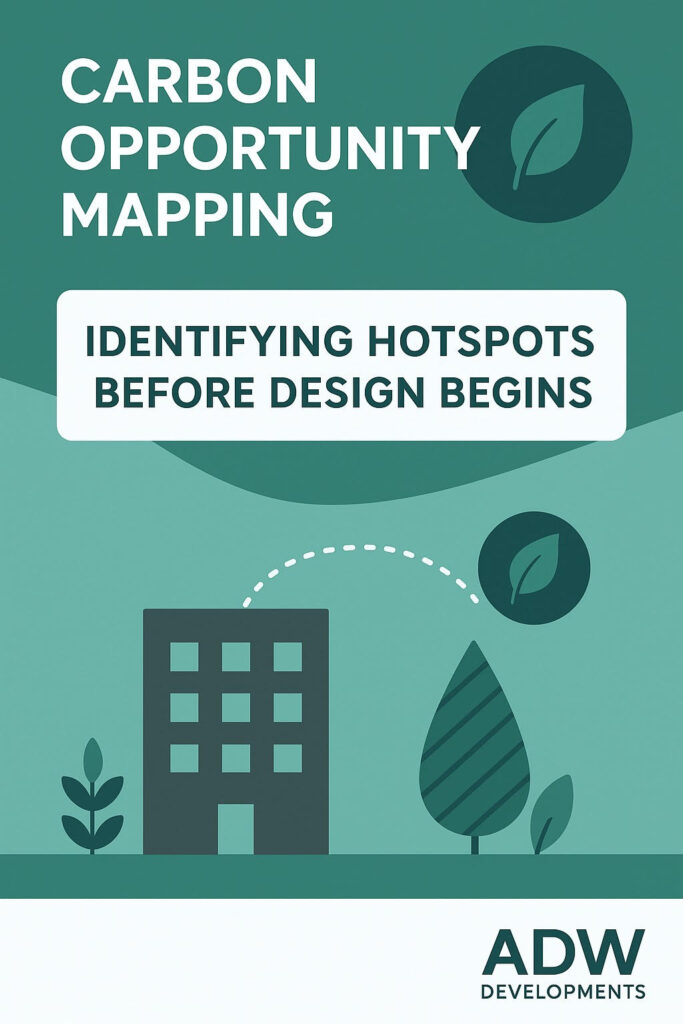Carbon Opportunity Mapping reveals where carbon hides before design begins. Early choices shape most of a project’s emissions, and once the design reaches a fixed point, the chance for cutting carbon narrows sharply. This is why in today’s Knowledge Share, we break down how carbon mapping guides smarter, lower-impact decisions from day one.
Why Early Carbon Mapping Matters

Early carbon mapping helps design and development teams pinpoint where emissions concentrate and which elements offer the greatest potential for improvement. It creates a clear picture of both embodied and operational carbon long before detailed modelling or procurement start.
This proactive step can:
- Prevent costly redesigns later in the programme
- Identify material choices with the largest carbon reduction potential
- Support BREEAM, Whole Life Carbon (WLC), and planning obligations
- Strengthen net-zero strategies and ESG performance
By embedding carbon awareness from the outset, teams can design for efficiency rather than attempting to retrofit sustainability at the end.
What Carbon Opportunity Mapping Involves
Although each project differs, carbon opportunity mapping typically includes several connected stages:
1. Establishing a Baseline
A high-level estimate of embodied and operational carbon is produced, using known information such as building type, area and structural strategy. This provides a benchmark for evaluating alternative options.
2. Identifying Carbon Hotspots
The most significant contributors, usually structure, substructure, façade, and MEP systems, are identified early, ensuring efforts are focused where they will deliver the greatest impact.
3. Exploring Alternative Scenarios
Different design routes are compared, such as structural systems, massing options or material specifications. This helps identify reductions that can be achieved without compromising performance, cost or quality.
4. Evaluating Results
Each scenario’s carbon implications are assessed, enabling teams to understand the balance between embodied carbon, operational energy and other project priorities.
5. Embedding Carbon Thinking
The resulting “opportunity map” becomes a dynamic reference point, guiding decision-making and encouraging cross-disciplinary collaboration as the design progresses.
From Insight to Action
This leads us to the fact that Carbon Opportunity Mapping is an intelligent way of designing. By integrating this approach early, teams can:
- Target interventions with the highest carbon savings
- Align sustainability ambitions with cost efficiency
- Demonstrate leadership in responsible and low-carbon development
Ultimately, this method allows both developers and designers to make informed decisions backed by data rather than assumptions. It also reassures stakeholders that sustainability targets are deliverable, measurable and aligned with the project’s long-term value.
The Value of Acting Early
Early carbon mapping supports stronger performance across the project lifecycle. It complements frameworks such as BREEAM Mat 01, Whole Life Carbon Assessments, and Circular Economy Statements, helping teams remain not only compliant but genuinely forward-thinking.
By identifying carbon hotspots before design work begins, projects can significantly reduce embodied emissions, improve operational efficiency, and enhance asset value, while contributing meaningfully to the built environment’s transition to net zero.
The most effective sustainability decisions are made before the design even begins, and this is where ADW Developments can help you.
